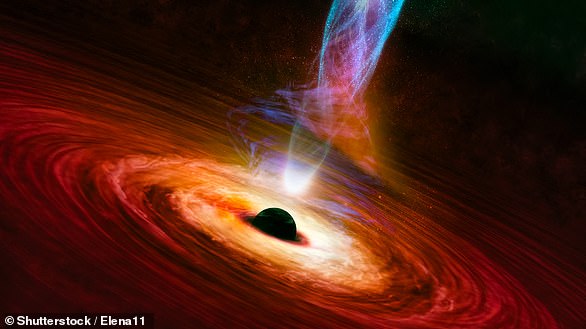Massive black hole suddenly AWAKENS: Terrifying images reveal the moment a void springs to life – and the same thing could happen at the centre of our own galaxy, scientists warn
Scientists have captured the ‘awakening’ of a supermassive black hole that unexpectedly comes to life.
More than 300 light-years away from Earth, in the constellation Virgo, this black hole had remained quietly hidden until it reactivated without warning in 2019.
This enormous void, which has more than 100,000 times the mass of our Sun, suddenly began to swallow the matter of the surrounding galaxy.
The black hole is now emitting so much light that an international team of scientists was able to witness the ‘unprecedented’ moment when it came back to life.
And the experts say this is something that could be happening at the core of our own Galaxy.
Researchers have captured the moments when a terrifying black hole “wakes up” from its slumber and begins eating its galaxy, as seen in this artist’s impression
Until recently, the galaxy SDSS1335+0728 was just a faint and relatively uninteresting part of space.
But in December 2019, scientists noticed that the star began emitting enormous amounts of infrared, ultraviolet and visible light.
Paula Sánchez Sáez, an astronomer at the European Southern Observatory in Germany and lead author of the study, said: ‘Imagine if you had been observing a distant galaxy for years, and it always seemed calm and inactive.
‘Suddenly the time has come [core] begins to show dramatic changes in brightness, unlike any typical event we have seen before.”
While it is not unusual for galaxies to become brighter, none of these explanations matched what scientists were seeing.
Supernovae, or tidal disruptions, where a star is torn apart by a black hole, produce a lot of light, but only for a very short period of time.
However, the Galaxy SDSS1335+0728 is still getting brighter, more than four years after it was first ‘turned on’.
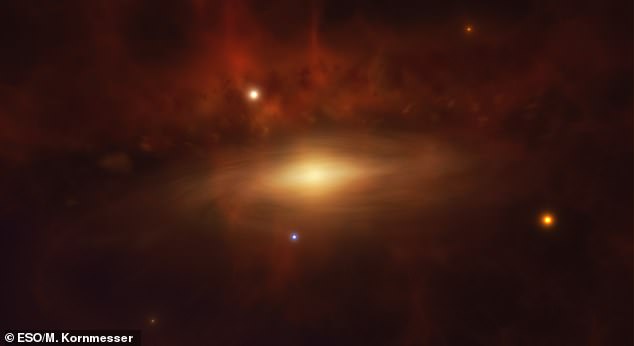
As this artist’s impression shows, before 2019 the galaxy was quite faint and contained no bright light at its core. This was because the supermassive black hole at the center was inactive
By combining observations from several telescopes around the world, including ESO’s Very Large Telescope (VLT), researchers have been able to monitor this process as it unfolds.
The data collected shows that the galaxy now produces four times as much UV radiation and twice as much infrared radiation, and has even started producing X-rays.
This provides strong evidence that the black hole has been activated, making it an ‘active galactic core’.
Co-author Lorena Hernández García, from the University of Valparaíso in Chile, says: ‘The most tangible option to explain this phenomenon is to see how the [core] of the Milky Way begins to show activity.
“If so, this would be the first time we’ve seen the activation of a massive black hole in real time.”
This gives scientists a unique opportunity to look at the inner workings of some of the most exotic objects in the universe.
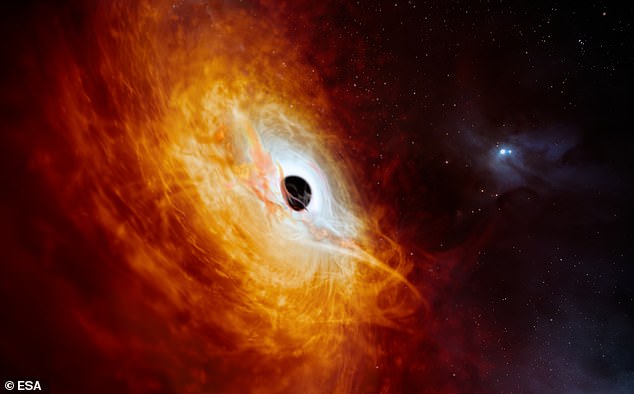
As black holes feed, the matter falling under their influence becomes extremely hot and bright. Scientists think it is the radiation from gases falling into the black hole that they can now observe (artist’s impression)
Black holes are so compact that not even light can escape their gravity, making them extremely difficult to observe.
Scientists can only observe the effects they have on the universe around them, either through gravitational lensing or through the light emitted by super-hot matter in orbit.
This means that when a black hole is inactive and no longer consuming matter, they are virtually invisible to our telescopes.
Co-author Claudio Ricci, from Diego Portales University in Chile, said: ‘These giant monsters are usually asleep and not immediately visible.
‘In the case of SDSS1335+0728 we were able to observe the awakening of the massive black hole, [which] suddenly began to feast on the gas available in the vicinity, and became very bright.’
This will not only give scientists data on how black holes work, but it could also give us a hint about the future of our galaxy, the Milky Way.
The largest black hole in the Milky Way is Sagittarius A*, at the center of the galaxy, with a solar mass of about 4 million – and spinning so fast that it has taken the shape of a football.
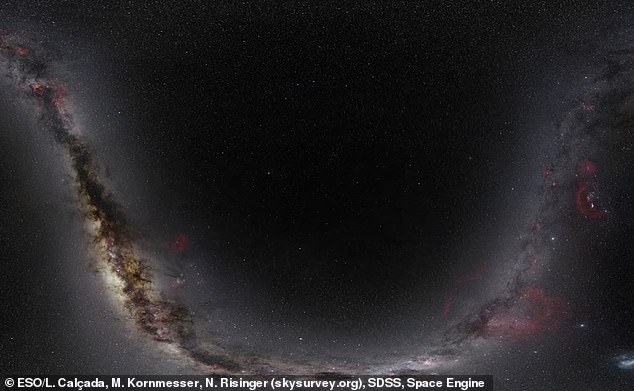
Although the Galaxy SDSS1335+0728 is more than 300 light-years away in a region of space called the constellation Virgo (pictured), researchers think we can use it to learn more about the supermassive black hole at the center of our own galaxy.
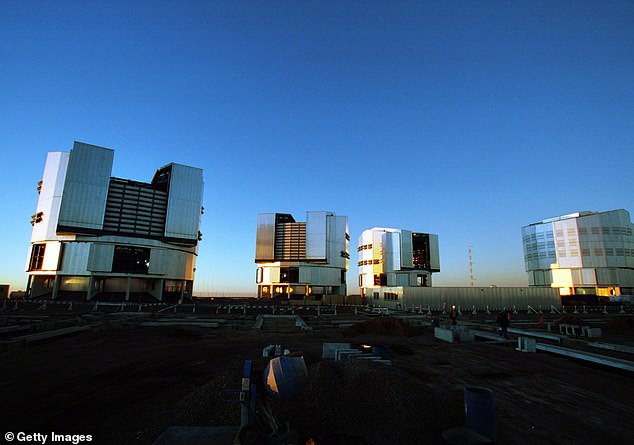
Pictured are the instruments that make up the Very Large Telescope in the remote, sparsely populated Atacama Desert of northern Chile
Lead author Dr. Sáez told MailOnline: ‘The black hole at the center of our Galaxy, Sagittarius A*, is currently in a dormant phase, but we cannot ignore that in the future. It may go through a process similar to that observed in SDSS1335+0728.”
Dr. However, Sáez also notes that it is uncertain how likely this will happen.”
She says: ‘So we are not at risk, and if it is triggered, nothing will probably happen to the solar system, because we are very far from the center of the Milky Way.
“But we will probably see spectacular light coming from the galactic center.”
The researchers say more tests will be needed to rule out alternative explanations, but that reactivation of the black hole remains the most likely explanation.
For example, they note that this could be caused by an exceptionally slow ‘tidal disruption’ – when a star is torn apart by the strong gravity of a nearby supermassive black hole.
Still, this would have to be either the longest and weakest tidal disruption ever observed, or an even more unusual, previously unknown type of event.
Dr. Sáez concludes: ‘Regardless of the nature of the variations, [this galaxy] provides valuable information about how black holes grow and evolve.’

